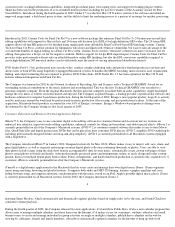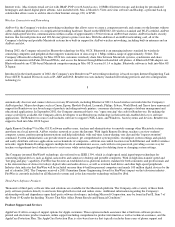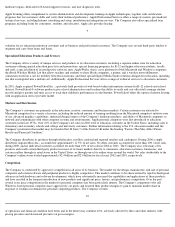Apple 2002 Annual Report Download - page 17
Download and view the complete annual report
Please find page 17 of the 2002 Apple annual report below. You can navigate through the pages in the report by either clicking on the pages listed below, or by using the keyword search tool below to find specific information within the annual report.
Form 10-K. All information presented herein is based on the Company's fiscal calendar.
Critical Accounting Policies
The preparation of financial statements and related disclosures in conformity with generally accepted accounting principles and the Company's
discussion and analysis of its financial condition and results of operations requires the Company's management to make judgments,
assumptions and estimates that affect the amounts reported in its consolidated financial statements and accompanying notes. Note 1 of the
Notes to Consolidated Financial Statements in Item 8 of this Form 10
-K describe the significant accounting policies and methods used in the
preparation of the Company's consolidated financial statements. Management bases its estimates on historical experience and on various other
assumptions that it believes to be reasonable under the circumstances, the results of which form the basis for making judgments about the
carrying values of assets and liabilities. Actual results may differ from these estimates.
Management believes the following to be critical accounting policies. That is, they are both important to the portrayal of the Company's
financial condition and results, and they require management to make judgments and estimates about matters that are inherently uncertain.
Revenue Recognition
The Company recognizes revenue pursuant to applicable accounting standards, including Statement of Position (SOP) No. 97-2, Software
Revenue Recognition
, as amended, and Securities and Exchange Commission (SEC) Staff Accounting Bulletin (SAB) No. 101, Revenue
Recognition in Financial Statements
. SAB 101, as amended, summarizes certain of the SEC's views in applying generally accepted accounting
principles to revenue recognition in financial statements and provides guidance on revenue recognition issues in the absence of authoritative
literature addressing a specific arrangement or a specific industry.
The Company recognizes revenue when persuasive evidence of an arrangement exists, delivery has occurred, the sales price is fixed or
determinable, and collectibility is probable. Product is considered delivered to the customer once it has been shipped, and title and risk of loss
have been transferred. Revenue on multiple element sales arrangements is allocated to various elements based on vendor specific objective
evidence of the fair value of each element of the transaction and is recognized as each element is delivered.
The Company records reductions to revenue for estimated commitments related to price protection and for customer incentive programs,
including reseller and end user rebates and other sales programs and volume-
based incentives. Future market conditions and product transitions
may require the Company to increase customer incentive programs and incur incremental price protection obligations that could result in
incremental reductions of revenue at the time such programs are offered. Additionally, certain customer
19
incentive programs require management to estimate the number of customers who will actually redeem the incentive based on historical
experience and the specific terms and conditions of particular incentive programs. If a greater than estimated proportion of customers redeem
such incentives, the Company would be required to record additional reductions to revenue.
Allowance for Doubtful Accounts
The Company distributes its products through third-party computer resellers and directly to certain education, consumer, and commercial
customers. The Company generally does not require collateral from its customers. However, when possible, the Company does attempt to limit
credit risk on trade receivables through the use of flooring arrangements for selected customers with third-
party financing companies and credit
insurance for certain customers in Europe, Asia, and Latin America. However, considerable trade receivables that are not covered by collateral,
flooring arrangements, or credit insurance are outstanding with the Company's distribution and retail channel partners.
The allowance for doubtful accounts is based on management's assessment of the collectibility of specific customer accounts and includes
consideration of the credit worthiness and financial condition of those specific customers. The Company records an allowance to reduce the
specific receivables to the amount that is reasonably believed to be collectible. The Company also records an allowance for all other trade
receivables based on multiple factors including historical experience with bad debts, the general economic environment, the financial condition
of the Company's distribution channels, and the aging of such receivables. If there is a deterioration of a major customer's financial condition, if
the Company becomes aware of additional information related to the credit worthiness of a major customer, or if future actual default rates on
trade receivables in general differ from those currently anticipated, the Company may have to adjust its allowance for doubtful accounts, which
would affect earnings in the period the adjustments are made.
Inventory Valuation and Inventory Purchase Commitments
The Company must order components for its products and build inventory in advance of product shipments. The Company records a write-
down for inventories of components and products, including third-party products held for resale, which have become obsolete or are in excess
of anticipated demand or net realizable value. The Company performs a detailed review of inventory each period that considers multiple factors
























